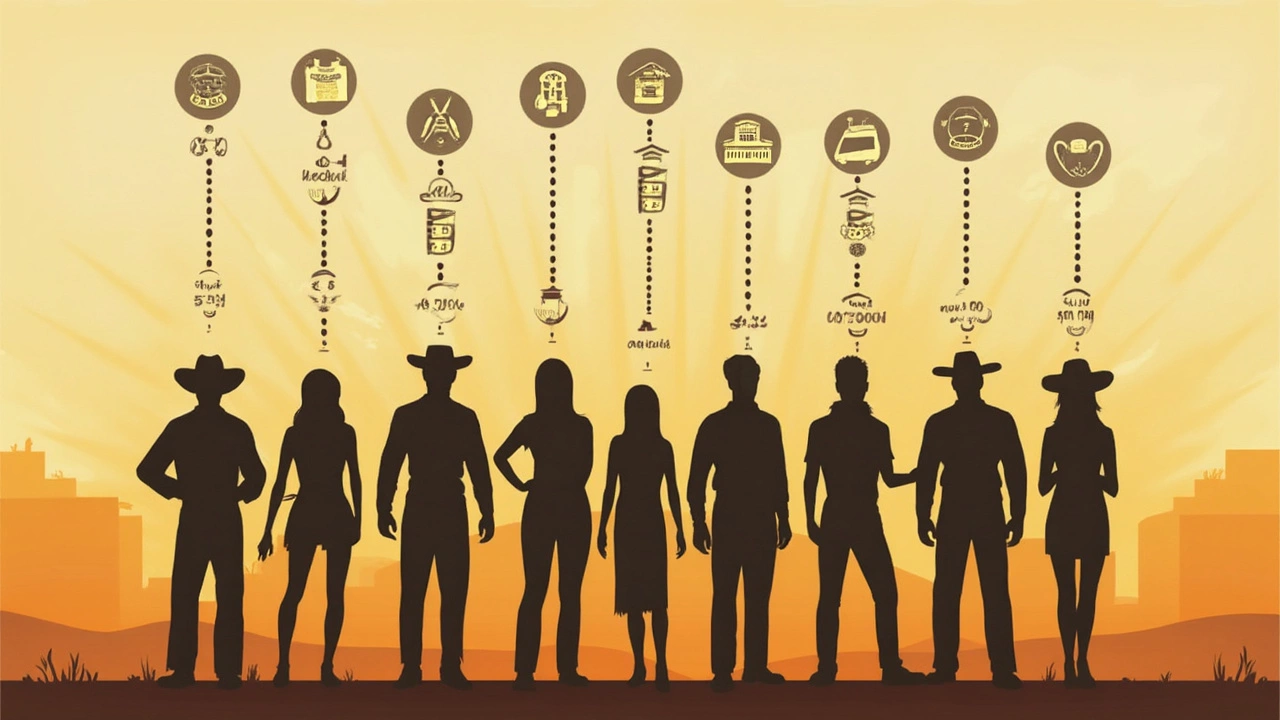Did you know that in Texas, a full-time salary under $30,000 isn’t just stressful—it’s actually below the poverty line for many families? A lot of folks are hustling every day and still not clearing that bar. If you’re earning around minimum wage here, you’re at real risk of not making ends meet, especially if you have kids or anyone else depending on you.
Don’t be fooled by those catchy headlines about Texas being super affordable. Sure, some things cost less, but housing, food, and childcare can eat up almost every dollar. Whether you’re living in Houston, Dallas, or a small town, there’s a line—if your pay falls below it, most would call that poor.
This isn’t just about numbers on a page. It touches every part of life: rent or mortgage, what you put on the table, and even healthcare. And if you’re worried about losing your home, there are shelters and organizations across Texas trying to help, even if it’s just a hot meal or a safe bed for a night.
- Defining Poverty: The Real Numbers in Texas
- Cost of Living vs. Wages: Where the Gaps Show
- Impacts of Being Below the Line
- Homeless Shelters and Local Support
- Tips for Anyone Struggling to Make Ends Meet
Defining Poverty: The Real Numbers in Texas
If you want to know if your salary counts as poor in Texas, you’ve got to look at the Texas poverty line. This isn’t a random number—it's set by the federal government each year and changes depending on family size. In 2024, the poverty line for a single adult was about $14,580 a year. If you’re part of a family of four, that number jumps to $30,000. So if you’re earning less than that, you’re officially considered under the poverty line here.
Here’s how those numbers look laid out simply:
| Household Size | Annual Income (Poverty Line, 2024) |
|---|---|
| 1 | $14,580 |
| 2 | $19,720 |
| 3 | $24,860 |
| 4 | $30,000 |
If you’re single and making under $15,000, or a family of four bringing in under $30,000, you fit the criteria for what’s officially considered poor.
But that’s only part of the story. Texas also has a lot of folks who sit just above the official line but still can’t cover basic expenses. That’s where the term “low income” comes in, usually about twice the federal poverty limit. So for a family of four, anything under $60,000 a year is still considered low income and you might qualify for help.
Why are these numbers important? They decide who gets certain benefits—like food assistance, Medicaid, or housing aid. And they shine a big spotlight on the fact that minimum wage jobs in Texas (currently $7.25 an hour) don’t come close to cutting it for families. If you’re thinking that doesn’t sound livable, you’re right.
If you want to know more about low income or homeless shelters Texas support, keep reading—knowing these numbers is the first step in getting help or understanding just what qualifies as “poor” in the Lone Star State.
Cost of Living vs. Wages: Where the Gaps Show
Here’s the not-so-pretty truth: the numbers for the cost of living in Texas aren’t lining up with most folks’ paychecks. Let’s look at some basics. Right now, minimum wage in Texas is $7.25 an hour. That’s $15,080 if you’re working full-time, no overtime or days off. Does that even pay for rent? Not really. The average monthly rent for a one-bedroom apartment in cities like Austin or Dallas can run $1,200 and up. Multiply that by 12 months, and rent alone nearly wipes out your paycheck.
It isn’t just rent, though. Groceries, gas, insurance, medical bills—they’re all adding up a lot faster than wages. Families with kids, especially single parents, feel this crunch even harder. Childcare in Texas often costs as much as rent itself. So that low income Texas line isn’t just about one thing being expensive; it’s everything.
| Expense | Average Monthly Cost (2024) |
|---|---|
| Rent (1-bedroom, Dallas) | $1,230 |
| Groceries (per person) | $350 |
| Childcare (per child) | $900 |
| Health Insurance | $425 |
Add up just these basics, and you’re already looking at over $2,900 a month, or $34,800 a year, well above a minimum wage salary. If two adults are working minimum wage jobs, they still might scrape by—barely—but a single income? No chance.
The Texas poverty line for a single adult is around $15,060 a year in 2024. For a family of four, it’s about $31,200. Now look back at those monthly bills. You can see why so many people feel broke even if they’re working full time.
- If you’re earning much below $16 an hour, you’ll probably need a roommate, major budgeting, or outside help just to stay afloat.
- Suburbs and small towns are a little cheaper, but good jobs are often harder to find, so it’s a trade-off.
- Wages aren’t keeping up with rising prices, especially in cities where jobs are most available.
So if you feel like your paycheck disappears the minute it lands, you’re definitely not imagining it. The gap between what things cost and what most people actually earn is real, and it’s getting wider for a lot of Texans.

Impacts of Being Below the Line
When your income slips under the Texas poverty line, things can spiral fast. Most folks feel it first with housing. The average Texas rent now floats above $1,200 a month for a one-bedroom. If you're making less than $30,000 a year, that's over half your paycheck gone before food or gas enters the picture. No wonder eviction notices are such a common sight.
Food insecurity is another big hit. The USDA says Texas families earning under the poverty line are three times more likely to skip meals or rely on food banks. Grocery costs have shot up since 2022—so those weekly shopping trips start meaning tough choices.
Kiddos really feel the pressure. Schools in lower-income neighborhoods often have fewer resources, and health problems crop up more since low-income families can’t always afford medical care. Texas has one of the highest rates of uninsured people in the country, which is a nightmare if someone gets sick or hurt.
Even working multiple jobs doesn’t always make things much better. Minimum wage in Texas is stuck at $7.25 an hour. If you’re clocking forty hours a week, you’d barely make $15,000 a year—way below what most would consider livable.
| Family Size | 2024 Federal Poverty Line (Texas) | Minimum Livable Wage (MIT Living Wage Calculator) |
|---|---|---|
| Single Adult | $15,060 | $34,557 |
| Single + 1 Child | $20,440 | $69,665 |
| Family of 4 | $31,200 | $80,332 |
Mental health takes a beating, too. Worrying if you’ll cover the rent or utilities racks up stress, which can make jobs and relationships a lot harder. Plus, with social class gaps, even finding help can be tough—funding for support programs in Texas is already stretched.
- More than 4 million Texans lived below the poverty line in 2023.
- The most common jobs for those affected? Food service, retail, and home health care—usually at minimum wage.
- Access to affordable housing is shrinking in big cities, but rural Texans don’t have it easy either—distance means higher travel costs for any essentials.
All this means that being below the Texas salary poor line isn’t just about dollars. It affects every part of life, pushing tough choices onto families and forcing many to turn to homeless shelters and food programs for help.
Homeless Shelters and Local Support
When your paycheck can barely cover rent or groceries, homeless shelters in Texas end up as the last line of defense for a lot of people. You might not know this, but cities like Dallas, Houston, and Austin all have well-known shelters like The Bridge, Star of Hope, and Front Steps. These don’t just hand out beds—they offer things like job training, free meals, showers, and sometimes even help with housing applications. No need to wait until you’re actually homeless to ask for help either—a bunch of these groups run hotlines and can point you to local resources before things get desperate.
Check out the kind of help you can expect at most shelters:
- Temporary beds and safe places to sleep
- Three meals a day in most big city shelters
- Case managers who actually sit with you and help plan your next steps
- Access to showers, laundry, and basic health clinics right on site
- Connections to job training or resume help, specifically for folks in low income Texas situations
- Family areas if you have young kids—it’s not just single adults getting services
In 2023, about 27,000 people in Texas used emergency shelters or transitional housing, according to the Texas Homeless Network. That number doesn’t even count those staying with friends or living out of cars. Real talk—demand is always higher than the number of beds available. So if you need shelter, try to call ahead or check websites early in the morning when new beds usually open up.
Don’t miss out on city programs and local nonprofits either. For example, Austin Resource Center for the Homeless (ARCH) offers not just food and shelter but help with things like medical exams and ID replacement, which are hurdles to moving forward when you’re stuck below the Texas poverty line.
If you ever feel stuck, 211 Texas is a free, confidential phone line run by the state. You can call or search online to get help with everything from shelters and food banks to mental health support. A lot of people are surprised how much is out there—it’s just not always easy to find unless you ask.

Tips for Anyone Struggling to Make Ends Meet
If you’re making a Texas low income or sitting close to the Texas poverty line, there are solid moves you can make to stretch your dollars. It's definitely tough out there, but you’re not stuck with zero options. Let’s get practical.
- Check if you qualify for programs: Texas has support like SNAP (food stamps), Medicaid, and utility bill help, especially for folks under certain salary limits. It only takes a few minutes to check your status on yourtexasbenefits.com. You’d be surprised how many skip this step.
- Look for free or reduced-cost clinics: The Texas Association of Community Health Centers runs clinics that treat patients even if you can’t pay the full price. Some are based in schools or churches too.
- Track your spending, even if it’s basic: Just jotting down what you spend for a week can uncover stuff you’re paying for without thinking—like random subscriptions or extra phone fees.
- Local food banks and pantries: Most cities in Texas have food banks, and nobody checks your immigration status. The North Texas Food Bank and Houston Food Bank are known to provide groceries at no cost.
- Find help with rent and utilities: Organizations like Texas Rent Relief or local churches sometimes step in to cover bills as a one-off when you’re facing eviction or late shutoff notices.
It’s also a good idea to connect with nearby job centers. Some offer short skills classes, resume help, and access to Texas salary jobs that pay above the minimum wage. Even if you just land a part-time gig that pays a few dollars more an hour, you could be looking at $200–$300 extra per month.
| Full-Time Min Wage | Avg. 1-Bed Rent | |
|---|---|---|
| Dallas | $1,160 | $1,305 |
| Houston | $1,160 | $1,188 |
| San Antonio | $1,160 | $1,126 |
If those rents look higher than minimum wage paychecks, you’re not imagining things. That’s one big reason homeless shelters in Texas see steady demand. Don’t wait until you’re in crisis before reaching out for help—there’s no shame at all in getting a little support while you get back on track.
